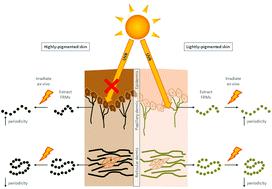当前位置:
X-MOL 学术
›
Photochem. Photobiol. Sci.
›
论文详情
Our official English website, www.x-mol.net, welcomes your feedback! (Note: you will need to create a separate account there.)
Remodelling of fibrillin-rich microfibrils by solar-simulated radiation: impact of skin ethnicity.
Photochemical & Photobiological Sciences ( IF 3.1 ) Pub Date : 2020-07-15 , DOI: 10.1039/d0pp00188k Abigail K Langton 1, 2 , Mark Hann 3 , Patrick Costello 1 , Poonam Halai 1 , Christopher E M Griffiths 1, 2 , Michael J Sherratt 4 , Rachel E B Watson 1, 2
Photochemical & Photobiological Sciences ( IF 3.1 ) Pub Date : 2020-07-15 , DOI: 10.1039/d0pp00188k Abigail K Langton 1, 2 , Mark Hann 3 , Patrick Costello 1 , Poonam Halai 1 , Christopher E M Griffiths 1, 2 , Michael J Sherratt 4 , Rachel E B Watson 1, 2
Affiliation

|
Fibrillin-rich microfibrils (FRMs) constitute integral components of the dermal elastic fibre network with a distinctive ultrastructural ‘beads-on-a-string’ appearance that can be visualised using atomic force microscopy and characterised by measurement of their length and inter-bead periodicity. Their deposition within the dermis in photoprotected skin appears to be contingent on skin ethnicity, and influences the ultrastructure of papillary – but not reticular – dermal FRMs. Truncation and depletion of FRMs at the dermal-epidermal junction of skin occurs early in photoageing in people with lightly pigmented skin; a process of accelerated skin ageing that arises due to chronic sun exposure. Accumulation of ultraviolet radiation (UVR)-induced damage, either by the action of enzymes, oxidation or direct photon absorption, results in FRM remodelling and changes to ultrastructure. In the current study, the direct effect of UVR exposure on FRM ultrastructure was assayed by isolating FRMs from the papillary and reticular dermis of photoprotected buttock skin of individuals of either black African or white Northern European ancestry and exposing them to solar-simulated radiation (SSR). Exposure to SSR resulted in significant reduction in inter-bead periodicity for reticular dermis-derived FRMs across both cohorts. In contrast, papillary dermal FRMs exhibited significantly increased inter-bead periodicity, with the magnitude of damage greater for African FRMs, as compared to Northern European FRMs. Our data suggest that FRMs of the dermis should be considered as two distinct populations that differentially accrue damage in response to SSR. Furthermore, papillary dermal FRMs derived from black African subjects show greater change following UVR challenge, when extracted from skin. Future studies should focus on understanding the consequences of UVR exposure in vivo, regardless of skin ethnicity, on the molecular composition of FRMs and how this UVR-induced remodelling may affect the role FRMs play in skin homeostasis.
中文翻译:

通过太阳模拟辐射重塑富含原纤维的微纤维:皮肤种族的影响。
富含原纤维的微纤维(FRM)构成真皮弹性纤维网络的组成部分,具有独特的超微结构“串珠”外观,可使用原子力显微镜观察并通过测量其长度和珠间周期性来表征。它们在受光保护的皮肤中真皮内的沉积似乎取决于皮肤的种族,并影响乳头状而非网状性皮肤FRM的超微结构。在皮肤颜色浅的人中,光老化初期会在皮肤的表皮交界处截断和清除FRM。由于长期暴露在阳光下而导致皮肤加速老化的过程。由于酶的作用,氧化作用或直接的光子吸收,紫外线辐射(UVR)引起的损害累积,导致FRM重塑并改变超微结构。在当前的研究中,通过从非洲黑人或北欧白人祖先的受光保护的臀部皮肤的乳头和网状真皮中分离FRM,并将它们暴露于太阳模拟辐射(SSR)中,分析了UVR暴露对FRM超微结构的直接影响。 )。在两个队列中,网状真皮源性FRM暴露于SSR会导致珠间周期性的显着降低。相比之下,与北欧FRM相比,乳头状真皮FRM的珠间周期性显着增加,非洲FRM的损害程度更大。我们的数据表明,真皮的FRM应该被视为两个不同的群体,它们对SSR的反应会产生不同的损害。此外,当从皮肤中提取时,源自非洲黑人受试者的乳头状真皮FRM在UVR攻击后显示出更大的变化。未来的研究应侧重于了解UVR暴露的后果在体内,无论皮肤种族如何,都取决于FRM的分子组成以及这种UVR诱导的重塑如何影响FRM在皮肤稳态中的作用。
更新日期:2020-09-16
中文翻译:

通过太阳模拟辐射重塑富含原纤维的微纤维:皮肤种族的影响。
富含原纤维的微纤维(FRM)构成真皮弹性纤维网络的组成部分,具有独特的超微结构“串珠”外观,可使用原子力显微镜观察并通过测量其长度和珠间周期性来表征。它们在受光保护的皮肤中真皮内的沉积似乎取决于皮肤的种族,并影响乳头状而非网状性皮肤FRM的超微结构。在皮肤颜色浅的人中,光老化初期会在皮肤的表皮交界处截断和清除FRM。由于长期暴露在阳光下而导致皮肤加速老化的过程。由于酶的作用,氧化作用或直接的光子吸收,紫外线辐射(UVR)引起的损害累积,导致FRM重塑并改变超微结构。在当前的研究中,通过从非洲黑人或北欧白人祖先的受光保护的臀部皮肤的乳头和网状真皮中分离FRM,并将它们暴露于太阳模拟辐射(SSR)中,分析了UVR暴露对FRM超微结构的直接影响。 )。在两个队列中,网状真皮源性FRM暴露于SSR会导致珠间周期性的显着降低。相比之下,与北欧FRM相比,乳头状真皮FRM的珠间周期性显着增加,非洲FRM的损害程度更大。我们的数据表明,真皮的FRM应该被视为两个不同的群体,它们对SSR的反应会产生不同的损害。此外,当从皮肤中提取时,源自非洲黑人受试者的乳头状真皮FRM在UVR攻击后显示出更大的变化。未来的研究应侧重于了解UVR暴露的后果在体内,无论皮肤种族如何,都取决于FRM的分子组成以及这种UVR诱导的重塑如何影响FRM在皮肤稳态中的作用。



























 京公网安备 11010802027423号
京公网安备 11010802027423号